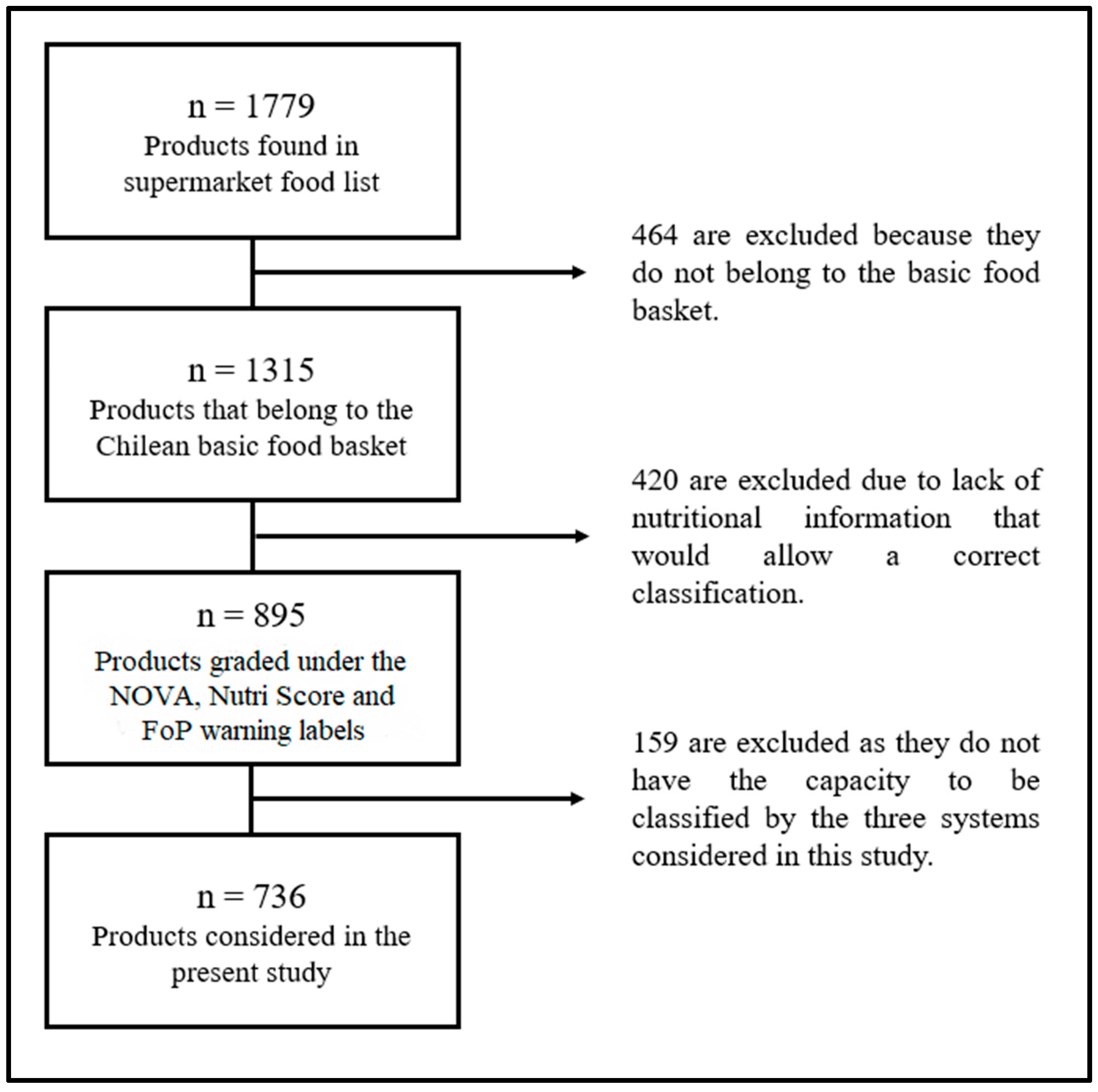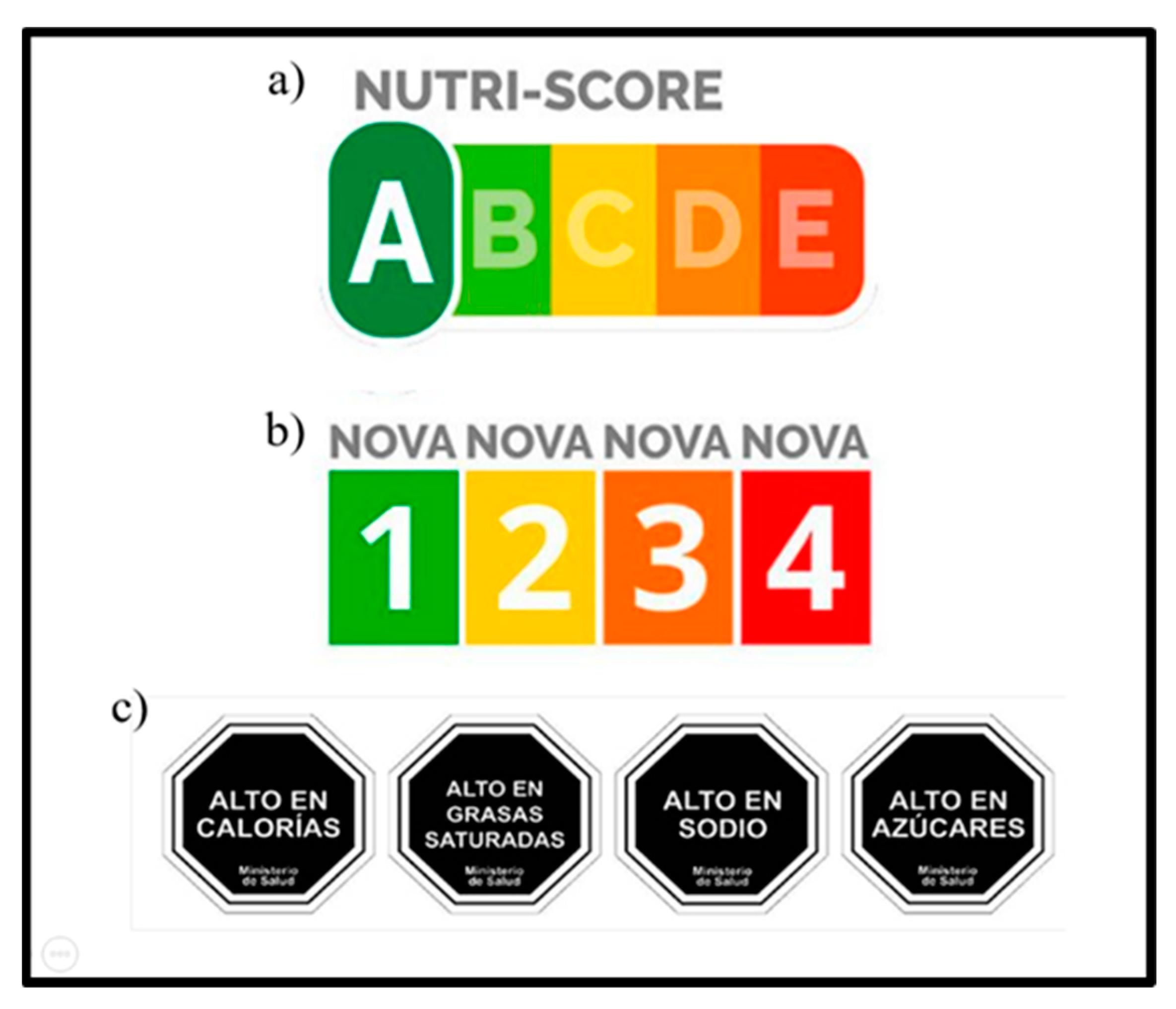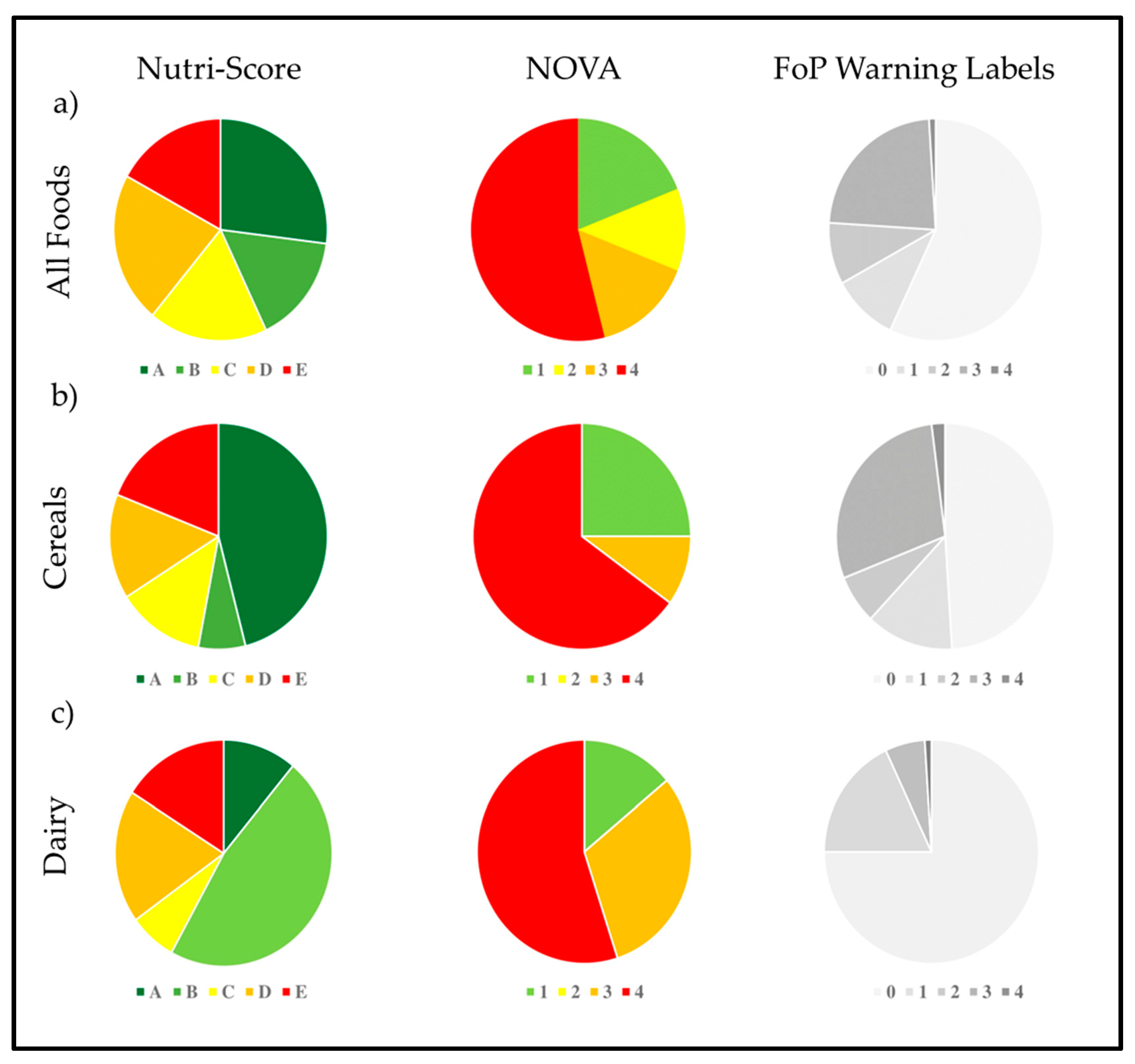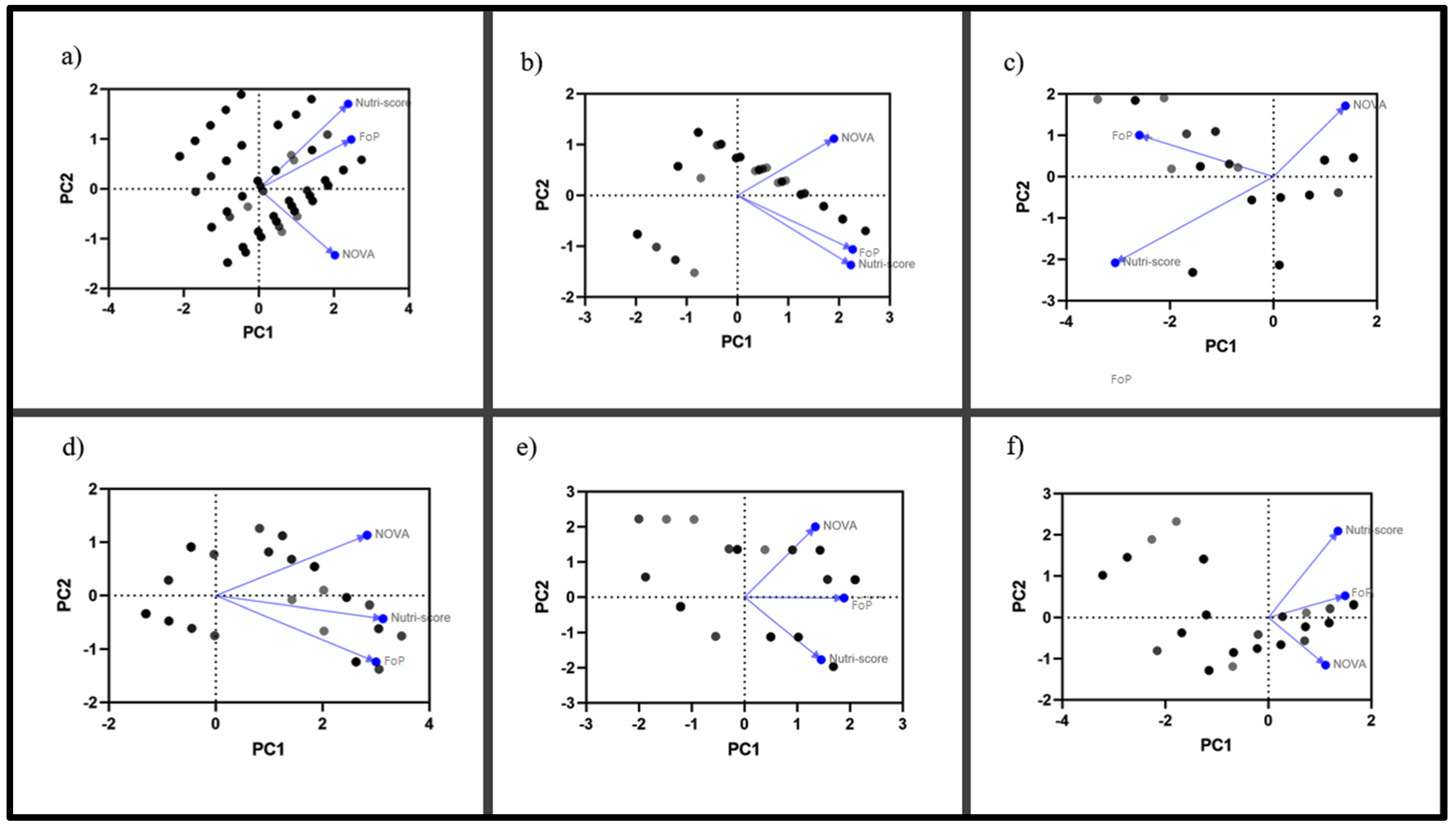Discrepancy between Food Classification Systems: Evaluation of Nutri-Score, NOVA Classification and Chilean Front-of-Package Food Warning Labels
Abstract
1. Introduction
2. Materials and Methods
2.1. Ranking Systems
2.1.1. Nutri-Score
2.1.2. NOVA System
2.1.3. FoP Warning Labels
2.1.4. Data Analysis
3. Results
4. Discussion
5. Conclusions
Author Contributions
Funding
Institutional Review Board Statement
Informed Consent Statement
Data Availability Statement
Acknowledgments
Conflicts of Interest
References
- World Health Organization. Global Health Risks: Mortality and Burden of Disease Attributable to Selected Major Risks; World Health Organization: Genève, Switzerland, 2009; p. 70. [Google Scholar]
- GBD 2015 Risk Factors Collaborators. Global, regional, and national comparative risk assessment of 79 behavioural, environmental and occupational, and metabolic risks or clusters of risks, 1990–2015: A systematic analysis for the Global Burden of Disease Study 2015. Lancet 2016, 388, 1659–1724. [Google Scholar] [CrossRef]
- Elizabeth, L.; Machado, P.; Zinöcker, M.; Baker, P.; Lawrence, M. Ultra-Processed Foods and Health Outcomes: A Narrative Review. Nutrients 2020, 12, 1955. [Google Scholar] [CrossRef]
- Romero Ferreiro, C.; Martín-Arriscado Arroba, C.; Cancelas Navia, P.; Lora Pablos, D.; Gómez de la Cámara, A. Ultra-processed food intake and all-cause mortality: DRECE cohort study. Public Health Nutr. 2021, 25, 1854–1863. [Google Scholar] [CrossRef]
- Rico-Campà, A.; Martínez-González, M.A.; Alvarez-Alvarez, I.; de Deus Mendonça, R.; De La Fuente-Arrillaga, C.; Gómez-Donoso, C.; Bes-Rastrollo, M. Association between consumption of ultra-processed foods and all cause mortality: SUN prospective cohort study. BMJ 2019, 365, 11949. [Google Scholar] [CrossRef]
- Blanco-Rojo, R.; Sandoval-Insausti, H.; López-Garcia, E.; Graciani, A.; Ordovás, J.M.; Banegas, J.R.; Rodríguez-Artalejo, F.; Guallar-Castillón, P. Consumption of Ultra-Processed Foods and Mortality: A National Prospective Cohort in Spain. Mayo Clin. Proc. 2019, 94, 2178–2188. [Google Scholar] [CrossRef]
- Neri, D.; Steele, E.M.; Khandpur, N.; Cediel, G.; Zapata, M.E.; Rauber, F.; Marrón-Ponce, J.A.; Machado, P.; Louzada, M.L.D.C.; Andrade, G.C.; et al. Ultraprocessed food consumption and dietary nutrient profiles associated with obesity: A multicountry study of children and adolescents. Obes. Rev. 2021, 23, e13387. [Google Scholar] [CrossRef] [PubMed]
- Serafim, P.; Borges, C.A.; Cabral-Miranda, W.; Jaime, P.C. Ultra-Processed Food Availability and Sociodemographic Associated Factors in a Brazilian Municipality. Front. Nutr. 2022, 9, 858–889. [Google Scholar] [CrossRef]
- Baraldi, L.G.; Martinez Steele, E.; Canella, D.S.; Monteiro, C.A. Consumption of ultra-processed foods and associated sociodemographic factors in the USA between 2007 and 2012: Evidence from a nationally representative cross-sectional study. BMJ Open 2018, 8, e020574. [Google Scholar] [CrossRef]
- Marchese, L.; Livingstone, K.M.; Woods, J.L.; Wingrove, K.; Machado, P. Ultra-processed food consumption, socio-demographics and diet quality in Australian adults. Public Health Nutr. 2021, 25, 94–104. [Google Scholar] [CrossRef] [PubMed]
- Moubarac, J.-C.; Parra, D.C.; Cannon, G.; Monteiro, C.A. Food Classification Systems Based on Food Processing: Significance and Implications for Policies and Actions: A Systematic Literature Review and Assessment. Curr. Obes. Rep. 2014, 3, 256–272. [Google Scholar] [CrossRef] [PubMed]
- Reyes, M.; Garmendia, M.L.; Olivares, S.; Aqueveque, C.; Zacarías, I.; Corvalán, C. Development of the Chilean front-of-package food warning label. BMC Public Health 2019, 19, 1–11. [Google Scholar] [CrossRef] [PubMed]
- Alaniz-Salinas, N.; Castillo-Montes, M. Evaluation of the front-of-package warning labels of the chilean food law by adults responsible for schoolchildren in the districts of la serena and coquimbo. Rev. Chil. De Nutr. 2020, 47, 738–749. [Google Scholar] [CrossRef]
- Monteiro, C.; Levi, R.; Moreira, R.; de Castro, I.R. A new classification of foods based on the extent and purpose of their processing. Cad Saúde Pública 2010, 26, 2039–2049. [Google Scholar] [CrossRef] [PubMed]
- Hercberg, S.; Touvier, M.; Salas-Salvado, J. The Nutri-Score nutrition label: A public health tool based on rigorous scientific evidence aiming to improve the nutritional status of the population. Int. J. Vitam. Nutr. Res. 2021, 92, 147–157. [Google Scholar] [CrossRef] [PubMed]
- Romero Ferreiro, C.; Lora Pablos, D.; Gómez de la Cámara, A. Two dimensions of nutritional value: Nutri-score and nova. Nutrients 2021, 13, 2783. [Google Scholar] [CrossRef]
- Taillie, L.S.; Reyes, M.; Colchero, M.A.; Popkin, B.; Corvalán, C. An evaluation of Chile’s Law of Food Labeling and Advertising on sugar-sweetened beverage purchases from 2015 to 2017: A before-and-after study. PLoS Med. 2020, 17, e1003015. [Google Scholar] [CrossRef]
- Wang, L.; Martínez Steele, E.; Du, M.; Pomeranz, J.L.; O’Connor, L.E.; Herrick, K.A.; Luo, H.; Zhang, X.; Mozaffarian, D.; Zhang, F.F. Trends in Consumption of Ultraprocessed Foods Among US Youths Aged 2–19 Years, 1999–2018. JAMA-J. Am. Med. Assoc. 2021, 326, 519–530. [Google Scholar] [CrossRef]
- Shim, J.-S.; Shim, S.Y.; Cha, H.-J.; Kim, J.; Kim, H.C. Association between Ultra-processed Food Consumption and Dietary Intake and Diet Quality in Korean Adults. J. Acad. Nutr. Diet. 2021, 122, 583–594. [Google Scholar] [CrossRef]
- Beslay, M.; Srour, B.; Méjean, C.; Allès, B.; Fiolet, T.; Debras, C.; Chazelas, E.; Deschasaux, M.; Wendeu-Foyet, M.G.; Hercberg, S. Ultra-processed food intake in association with BMI change and risk of overweight and obesity: A prospective analysis of the French NutriNet-Santé cohort. PLoS Med. 2020, 17, e1003256. [Google Scholar] [CrossRef] [PubMed]
- Schnabel, L.; Kesse-Guyot, E.; Allès, B.; Touvier, M.; Srour, B.; Hercberg, S.; Buscail, C.; Julia, C. Association between Ultraprocessed Food Consumption and Risk of Mortality among Middle-aged Adults in France. JAMA Intern. Med. 2019, 179, 490–498. [Google Scholar] [CrossRef]
- Monteiro, C.A.; Cannon, G.; Moubarac, J.-C.; Levy, R.B.; Louzada, M.L.C.; Jaime, P.C. The UN Decade of Nutrition, the NOVA Food Classification and the Trouble with Ultra-Processing. Public Health Nutr. 2018, 21, 5–17. [Google Scholar] [CrossRef] [PubMed]
- Hernández-F, M.; Figueroa, J.L.; Colchero, M.A. Association between density of stores and purchases of ultra-processed food and sugar-sweetened beverages in Mexico. Health Place 2021, 68, 102528. [Google Scholar] [CrossRef] [PubMed]
- Galán, P.; Kesse, E.; Touvier, M.; Deschasaux, M.; Srour, B.; Chazelas, E.; Baudry, J.; Fialon, M.; Julia, C.; Hercberg, S. Nutri-score and ultra-processing: Two different, complementary, non-contradictory dimensions. Nutr. Hospitalaria 2021, 38, 201–206. [Google Scholar] [CrossRef]
- Gómez-Donoso, C.; Martínez-González, M.A.; Bes-Rastrollo, M. Nutri-score, ultra-processed foods and health. An. Del Sist. Sanit. De Navarra. Gob. De Navar. 2021, 44, 5–8. [Google Scholar]
- Cooksey-Stowers, K.; Schwartz, M.B.; Brownell, K.D. Food Swamps Predict Obesity Rates Better Than Food Deserts in the United States. Int. J. Environ. Res. Public Health 2017, 14, 1366. [Google Scholar] [CrossRef] [PubMed]
- Braesco, V.; Souchon, I.; Sauvant, P.; Haurogné, T.; Maillot, M.; Féart, C.; Darmon, N. Ultra-processed foods: How functional is the NOVA system? Eur. J. Clin. Nutr. 2022, 76, 1245–1253. [Google Scholar] [CrossRef]
- Menichetti, G.; Ravandi, B.; Mozaffarian, D.; Barabási, A.L. Machine Learning Prediction of Food Processing. MedRxiv 2021. [Google Scholar] [CrossRef]
- Garg, M.; Sharma, N.; Sharma, S.; Kapoor, P.; Kumar, A.; Chunduri, V.; Arora, P. Biofortified Crops Generated by Breeding, Agronomy, and Transgenic Approaches Are Improving Lives of Millions of People around the World. Front. Nutr. 2018, 5, 12. [Google Scholar] [CrossRef]
- Das, J.K.; A Salam, R.; Bin Mahmood, S.; Moin, A.; Kumar, R.; Mukhtar, K.; Lassi, Z.S.; A Bhutta, Z. Food fortification with multiple micronutrients: Impact on health outcomes in general population. Cochrane Database Syst. Rev. 2019, 2019, CD011400. [Google Scholar] [CrossRef]
- Castillo, C.; Rivas, C. Costs of a basic food basket for celiac patients in Chile. Rev. Med. Chile 2008, 136, 613–619. [Google Scholar]
- Sak, J.; Suchodolska, M. Artificial Intelligence in Nutrients Science Research: A Review. Nutrients 2021, 13, 322. [Google Scholar] [CrossRef] [PubMed]
- Mezgec, S.; Eftimov, T.; Bucher, T.; Koroušić Seljak, B. Mixed deep learning and natural language processing method for fake-food image recognition and standardization to help automated dietary assessment. Public Health Nutr. 2019, 22, 1193–1202. [Google Scholar] [CrossRef] [PubMed]





| Nutri Score | NOVA 1 | NOVA 2 | NOVA 3 | NOVA 4 | Total |
|---|---|---|---|---|---|
| A | 107 (54.3%) | 3 (1.5%) | 50 (25.3%) | 37 (18.7%) | 197 |
| B | 17 (14.4%) | 3 (2.5%) | 15 (12.7%) | 83 (70.3%) | 118 |
| C | 7 (5.4%) | 39 (30.2%) | 16 (12.4%) | 67 (51.9%) | 129 |
| D | 4 (2.4%) | 40 (24.2%) | 25 (15.1%) | 96 (58.1%) | 165 |
| E | 8 (6.2%) | 4 (3.1%) | 3 (2.3%) | 112 (88.1%) | 127 |
| Total | 143 | 89 | 109 | 395 | 736 |
| Nutri Score | FoP 0 | FoP 1 | FoP 2 | FoP 3 | FoP 4 | Total |
|---|---|---|---|---|---|---|
| A | 187 (94.9%) | 8 (4.0%) | 1 (0.5%) | 1 (0.5%) | 0 (0%) | 197 |
| B | 101 (85.5%) | 12 (10.1%) | 4 (3.3%) | 1 (0.8%) | 0 (0%) | 118 |
| C | 82 (63.5%) | 21 (16.2%) | 17 (13.1%) | 9 (6.9%) | 0 (0%) | 129 |
| D | 39 (23.6%) | 28 (16.9%) | 36 (21.8%) | 62 (37.5%) | 0 (0%) | 165 |
| E | 12 (9.4%) | 4 (3.1%) | 9 (7%) | 98 (77.1%) | 4 (3.1%) | 127 |
| Total | 421 | 73 | 67 | 171 | 4 | 736 |
| NOVA | FoP 0 | FoP1 | FoP 2 | FoP 3 | FoP 4 | Total |
|---|---|---|---|---|---|---|
| 1 | 143 (100%) | 0 (0%) | 0 (0%) | 0 (0%) | 0 (0%) | 143 |
| 2 | 69 (77.5%) | 0 (0%) | 12 (13.4%) | 8 (8.9%) | 0 (0%) | 89 |
| 3 | 78 (71.5%) | 18 (16.5%) | 4 (3.6%) | 9 (8.2%) | 0 (0%) | 109 |
| 4 | 131 (33.2%) | 55 (13.9%) | 51 (12.9%) | 154 (38.9%) | 4 (1.0%) | 395 |
| Total | 421 | 73 | 67 | 171 | 4 | 736 |
Publisher’s Note: MDPI stays neutral with regard to jurisdictional claims in published maps and institutional affiliations. |
© 2022 by the authors. Licensee MDPI, Basel, Switzerland. This article is an open access article distributed under the terms and conditions of the Creative Commons Attribution (CC BY) license (https://creativecommons.org/licenses/by/4.0/).
Share and Cite
Valenzuela, A.; Zambrano, L.; Velásquez, R.; Groff, C.; Apablaza, T.; Riffo, C.; Moldenhauer, S.; Brisso, P.; Leonario-Rodriguez, M. Discrepancy between Food Classification Systems: Evaluation of Nutri-Score, NOVA Classification and Chilean Front-of-Package Food Warning Labels. Int. J. Environ. Res. Public Health 2022, 19, 14631. https://doi.org/10.3390/ijerph192214631
Valenzuela A, Zambrano L, Velásquez R, Groff C, Apablaza T, Riffo C, Moldenhauer S, Brisso P, Leonario-Rodriguez M. Discrepancy between Food Classification Systems: Evaluation of Nutri-Score, NOVA Classification and Chilean Front-of-Package Food Warning Labels. International Journal of Environmental Research and Public Health. 2022; 19(22):14631. https://doi.org/10.3390/ijerph192214631
Chicago/Turabian StyleValenzuela, Aranza, Leandro Zambrano, Rocío Velásquez, Catalina Groff, Tania Apablaza, Cecilia Riffo, Sandra Moldenhauer, Pamela Brisso, and Marcell Leonario-Rodriguez. 2022. "Discrepancy between Food Classification Systems: Evaluation of Nutri-Score, NOVA Classification and Chilean Front-of-Package Food Warning Labels" International Journal of Environmental Research and Public Health 19, no. 22: 14631. https://doi.org/10.3390/ijerph192214631
APA StyleValenzuela, A., Zambrano, L., Velásquez, R., Groff, C., Apablaza, T., Riffo, C., Moldenhauer, S., Brisso, P., & Leonario-Rodriguez, M. (2022). Discrepancy between Food Classification Systems: Evaluation of Nutri-Score, NOVA Classification and Chilean Front-of-Package Food Warning Labels. International Journal of Environmental Research and Public Health, 19(22), 14631. https://doi.org/10.3390/ijerph192214631








